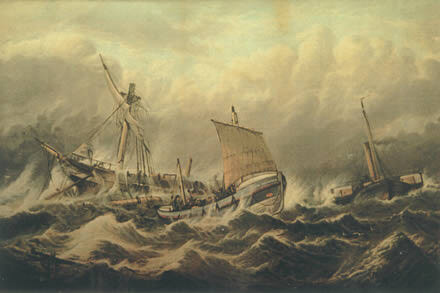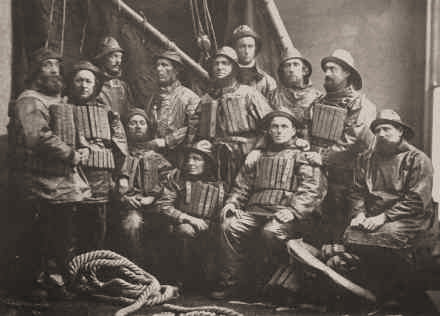’Twas on the 8th of January 1881,
That a terrific gale along the English Channel ran,
And spread death and disaster in its train,
Whereby the “Indian Chief” vessel was tossed on the raging main.
She was driven ashore on the Goodwin Sands,
And the good captain fearlessly issued hie commands,
“Come, my men, try and save the vessel, work with all your might,”
Although the poor sailors on board were in a fearful plight.
They were expecting every minute her hull would give way,
And they, poor souls, felt stricken with dismay,
And the captain and some of the crew clung to the main masts,
Where they were exposed to the wind’s cold blasts.
A fierce gale was blowing and the sea ran mountains high,
And the sailors on board heaved many a bitter sigh;
And in the teeth of the storm the lifeboat was rowed bravely
Towards the ship in distress, which was awful to see.
The ship was lifted high on the crest of a wave,
While the sailors tried hard their lives to save,
And implored God to save them from a watery grave,
And through fear some of them began to rave.
The waves were miles long in length;
And the sailors had lost nearly all their strength,
By striving hard their lives to save,
From being drowned in the briny wave.
A ration of rum and a biscuit was served out to each man,
And the weary night passed, and then appeared the morning dawn;
And when the lifeboat hove in sight a sailor did shout,
“Thank God, there’s she at last without any doubt.”
But, with weakness and the biting cold,
Several of the sailors let go their hold;
And, alas, fell into the yawning sea,
Poor souls! and were launched into eternity.
Oh, it was a most fearful plight,
For the poor sailors to be in the rigging all night;
While the storm fiend did laugh and roar,
And the big waves lashed the ship all o’er.
And as the lifeboat drew near,
The poor sailors raised a faint cheer;
And all the lifeboat men saw was a solitary mast,
And some sailors clinging to it, while the ship was sinking fast.
Charles Tait, the coxswain of the lifeboat, was a skilful boatman,
And the bravery he and his crew displayed was really grand;
For his men were hardy and a very heroic set,
And for bravery their equals it would be hard to get.
But, thank God, out of twenty-nine eleven were saved,
Owing to the way the lifeboat men behaved;
And when they landed with the eleven wreckers at Ramsgate,
The people’s joy was very great.
An inquest was held at Ramsgate on Friday, on the body of Howard Primrose Frazer, second mate of the Indian Chief, who died on board the Ramsgate lifeboat while being brought from the wrecked ship to shore. According to the evidence, the Indian Chief struck on the Long Sand at 3 o’clock on Wednesday morning. At midday she began to break up, and at 8 in the evening all hands had to take to the rigging. At about 3 o’clock on Thursday morning the main and mizzen masts went overboard. Frazer remained on the mast till the lifeboat took him off with 11 others at about 8 o’clock the same morning. He expired before the shore was reached. When the ship went on the sand she was in charge of a Hartlepool pilot. There was a strong breeze from E.N.E. It is stated that the vessel stranded owing to the fouling of some of her gear. Medical evidence was to the effect that death resulted from the cold and exposure. In summing up, the coroner said great credit was due to the lifeboat crew for their indomitable courage. Verdict – “Deceased died from exhaustion induced by exposure and cold.”
The Times, 10th January 1881
Notes
The 1,238 ton barque Indian Chief was only four days into its journey from Middlesborough to Yokohama when a north easterly gale drove it onto Long Sand, off Clacton-on-Sea at the mouth of the Thames. The crew lit beacon fires and rockets to summon help, and then took shelter in the cabins from the intensifying storm.
In the hours that followed, the Indian Chief was mercilessly pounded by the waves. The crew attempted to abandon ship, but the small boats were instantly engulfed by the heavy seas as soon as they were launched. By the end of the afternoon the hull of the ship was almost completely under water and the crew could only save themselves by climbing into the rigging and lashing themselves to the spars. All night the ship was battered, until a huge wave bore down the main and mizzen masts and all who clung to them. Only the foremast remained standing, with eleven of the crew clinging to it for dear life.
Meanwhile, Bradford, the Ramsgate lifeboat had been towed out towards the wreck by the paddle steamer Vulcan. Unable to find the stricken ship in the dark, the lifeboatmen spent an uncomfortable night huddled together as the two boats were tossed about by the storm. With the coming of daylight, they spotted what was left of the Indian Chief and made for it across the raging ocean.
Making fast to the stricken ship with a hawser, the Bradford took on board the eleven survivors from the foremast and one from the mizzen mast (who died before the lifeboat reached home). The rest of the 29-man crew had been drowned. It took several more hours of hard sailing before the lifeboat reached dry land.
 This rescue was one of the most heroic in the history of the Royal National Lifeboat Institution (RNLI). Charles Fish,the coxswain of the Bradford, was awarded a RNLI Gold Medal, whilst his eleven-man crew and the seven men aboard Vulcan were all awarded silver medals.
This rescue was one of the most heroic in the history of the Royal National Lifeboat Institution (RNLI). Charles Fish,the coxswain of the Bradford, was awarded a RNLI Gold Medal, whilst his eleven-man crew and the seven men aboard Vulcan were all awarded silver medals.
Further Reading
- Wreck of the Indian Chief – A full account of the rescue, including first-hand testimony from those involved
- Wreck Report for ‘Indian Chief’, 1881 – The official Board of Trade report on the wreck
- Harry Meader’s Sea Gallantry Medal – A medal awarded to one of the rescuers, now in the possession of the Fitzwilliam Museum in Cambridge. With much background information.

Did our man read about all these disasters in the Dundee Courier and then just change the order of the words in the report? That would explain everything. The Dundee Courier, a great read ya hoor ye.